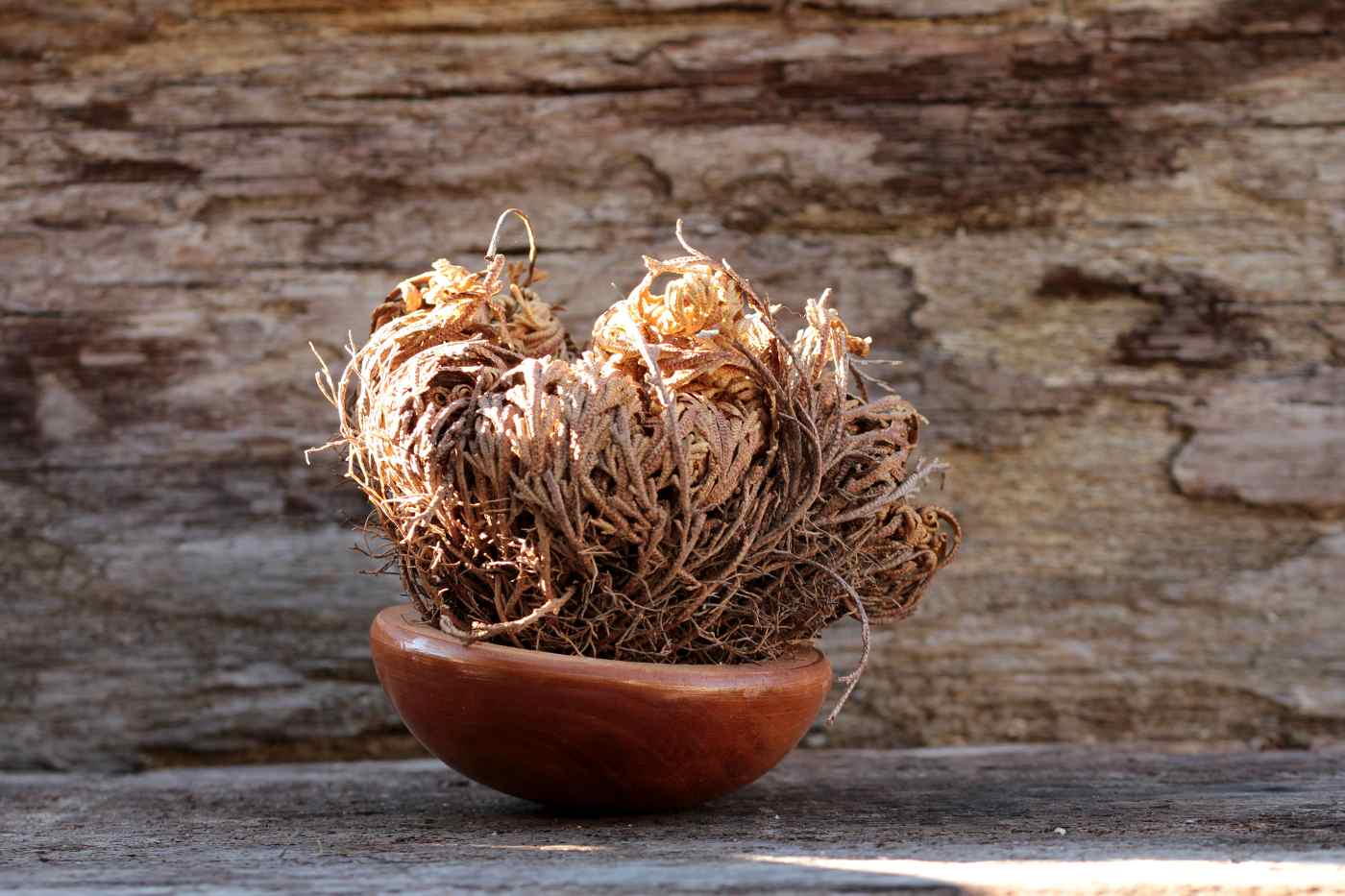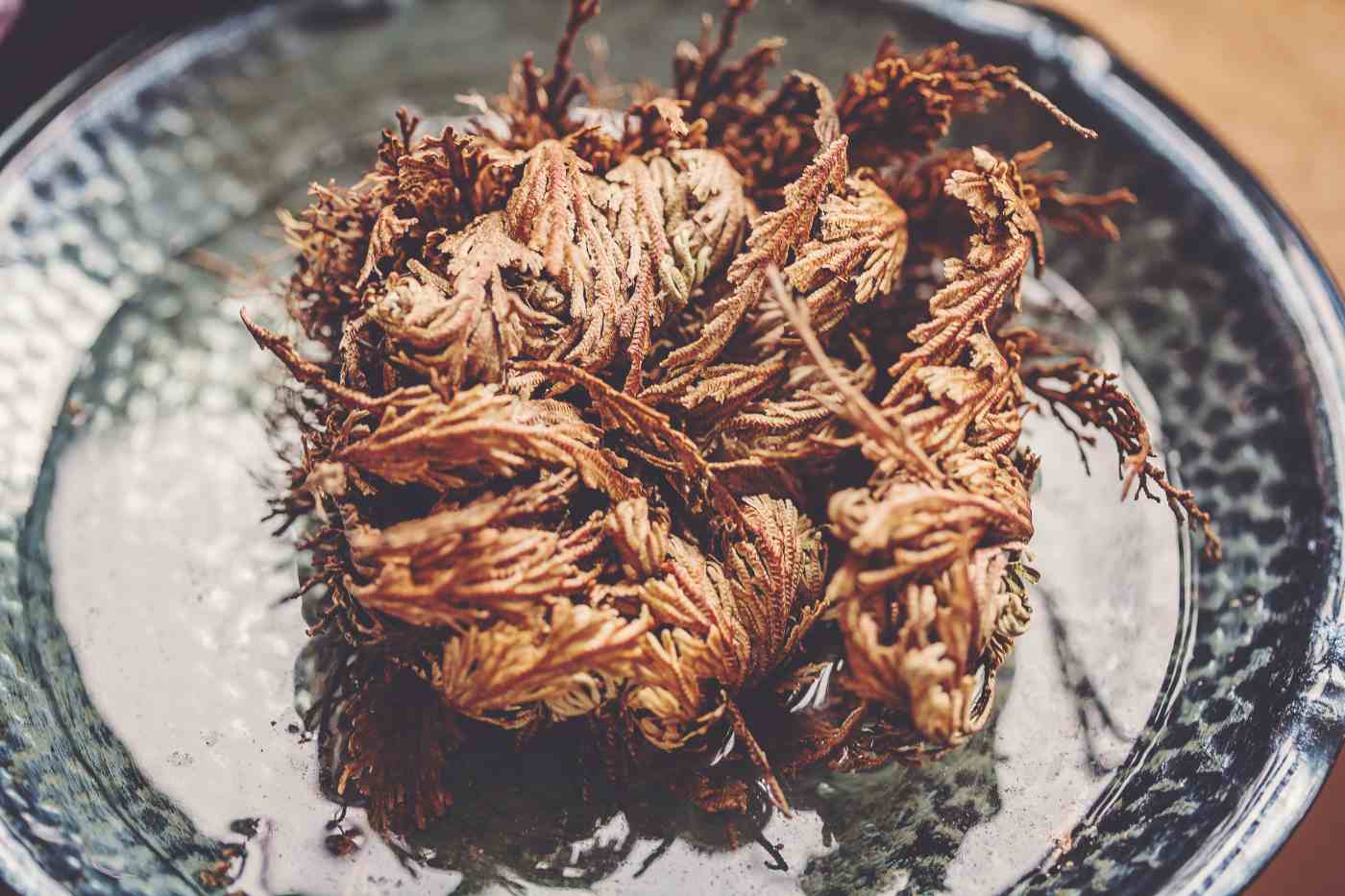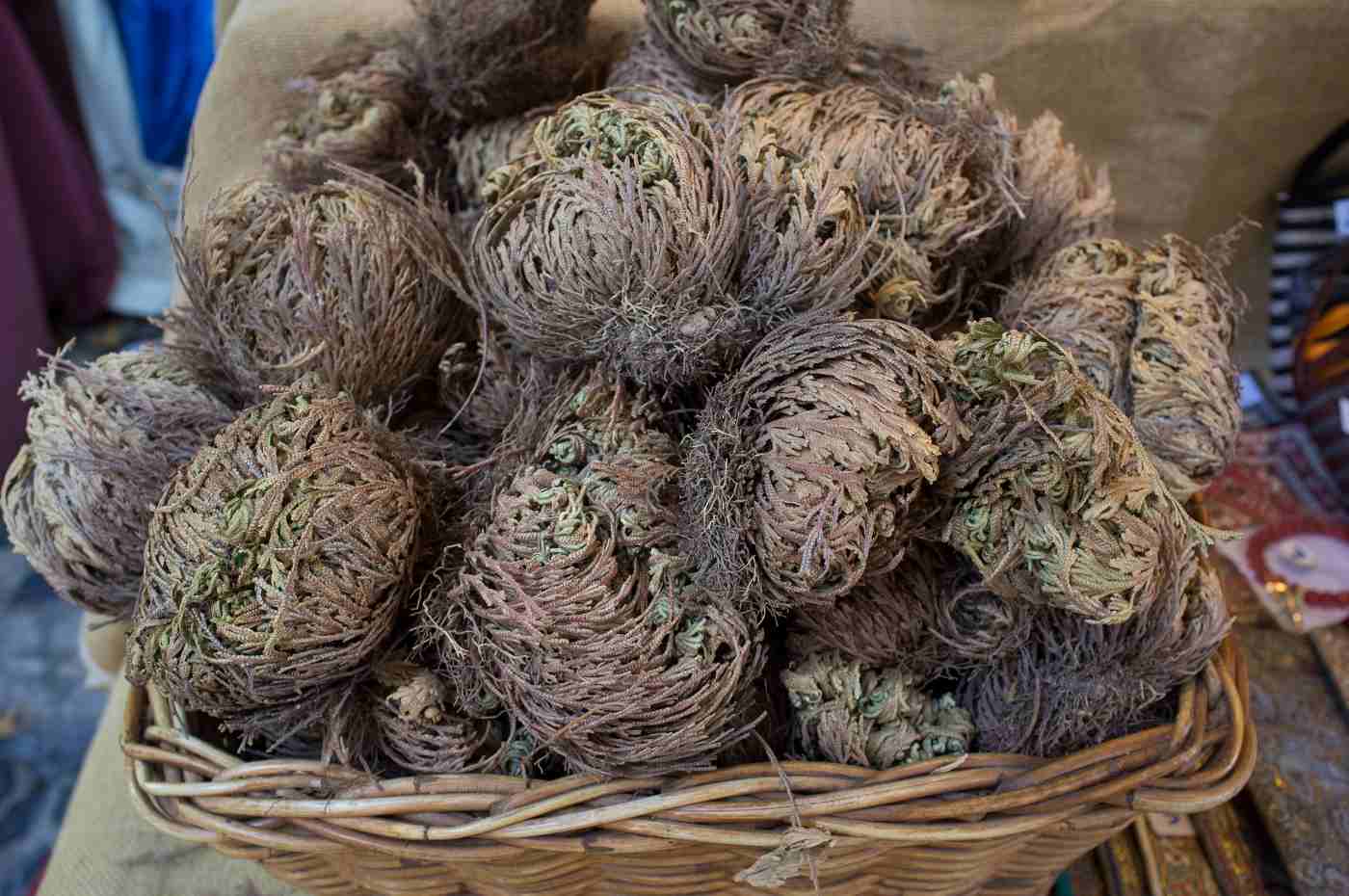The Rose of Jericho is a magical houseplant, not just because it’s literally been used for magical purposes throughout history (a history we’ve written about in our article “What is the Rose of Jericho and What Are Its Spiritual Uses?“), but also because it’s a remarkable plant that’s just about impossible to kill.
This article will offer some facts about the Rose of Jericho, walk you through basic Rose of Jericho plant care and answer some frequently asked questions about this incredible plant. Let’s get started.
Rose of Jericho Plant Facts
The first thing to know is that there are two types of Rose of Jericho: the true (Anastatica hierochuntica) and the false Rose of Jericho (Selaginella lepidophylla). These are completely different, unrelated plants that happen to share the ability to go dormant and appear dead but revive when exposed to moisture.
You can learn more about this biological feat from Matt Candeias over at In Defense of Plants. Maria-Cecília Costa of Frontiers for Young Minds also has an excellent and accessible explanation of how resurrection plants like Selaginella lepidophylla survive their apparent deaths.
The true Rose of Jericho originates in Western Asia and the Middle East. It belongs to the mustard family of plants. The false comes from the Chihuahuan desert of Mexico and is actually a kind of spikemoss.
In terms of appearance, true Rose of Jericho blooms with small white flowers and has a greyish foliage, while false Rose of Jericho has fern-like fronds that some people think resemble a rose when unfurled.
Many people say they prefer the look of Selaginella lepidophylla, which is fortunate, really, because it’s also easier to find and less expensive than Anastatica hierochuntica. Most of the Jericho plants we see nowadays are, in fact, Selaginella lepidophylla.
The biggest differences in terms of growing this plant is that Anastatica hierochuntica is an annual that grows new roots when it’s revived, while Selaginella lepidophylla is a perennial that regrows new roots from its old roots. This will only really matter, however, if you decide to grow your Jericho plant in soil (see below).
One last fact that’s really more of a question is, is Rose of Jericho toxic to cats? Given that Selaginella lepidophylla is part of the spikemoss family, it’s likely to be, so keep them away from feline friends.
Rose of Jericho Instructions
The instructions on how to care for a Rose of Jericho are pretty straightforward, but they do require some specific care, mostly in the water department. When you get your plant, it will be curled up in a dry ball. You’ll need to find a way to immerse the roots in water, without getting the rest of the plant wet—these are desert plants and they’re not meant to be soggy.
Some people place their plants right in a bowl of water. Others fill a bowl with rocks or pebbles and then fill the dish so the water line comes just above the pebbles. Then they sit the Rose of Jericho on the top. Whichever set up you choose, change the water every 1-2 days to keep it clean.
The biggest issue people have with these houseplants is overwatering. They’ll need a rest day from water every week or so to keep them from rotting. You can simply remove the plant from water and let it dry for a day before putting it back into your pot.
Rose of Jericho smell a bit stale, but if they start to smell rotten, that’s a sign that it needs to come out of the water more frequently.
Once a month, the plant should be removed from water and allowed to dry out entirely. It will shrivel and appear to die, but this is just a normal part of the plant’s cycle. Let the plant rest in its dry state and then you can return it to the pot and watch it unfurl and spring back to life.
Prune the dead tips if you like—Rose of Jericho doesn’t necessarily need pruning, but many people like to trim back dead leaves for the sake of aesthetics.
Does Rose of Jericho Need Sun?
Yes. Like all plants, your Rose will need some sunlight to thrive. In fact, low light tends to make them curl up. These plants do best in bright, indirect light, but you can also let them have a few hours of direct morning sunlight.
They like consistent temperatures, however, so avoid putting them in places where the sun will get too hot. Also keep them away from heating vents and drafty windows.
Can You Plant Rose of Jericho in Soil?
You can plant either species in soil if you don’t feel like having to remember to take your plant in and out of water. Most people recommend the water method, saying they have more success and that it’s easier, but if you want to forge ahead with soil, don’t let them stop you.
If you do forge ahead, revive your Rose first (if it’s not already in water) and keep it in water until its roots are established.
For Selaginella lepidophylla, that could take a day or two, but for Anastatica hierochuntica it could be anywhere from a week to 10 days since the plant will be growing fresh roots from scratch.
Once the roots are established, gently place the Jericho plant in a pot of moist, very well-draining, sandy soil. Follow the same sort of watering regimen as above. Water the plant daily, give the watering a rest one day per week and periodically allow the pot to dry out completely.
Don’t worry about fertilizer. These are hardy plants and really don’t require anything other than water and light.
Other Frequently Asked Questions (FAQ)
How to Care for Rose of Jericho?
Here’s the TLDR version of Rose of Jericho care. Place the dry plant in a dish of water so that only the roots are submerged. Change the water every day or two. Keep your plant in bright, indirect light, away from heating vents and drafts. Remove the plant from water once a week for a full day. Let it dry out fully once a month. Once it’s dry, put it in a safe, dark place. Rest and repeat.
How Long Does It Take for a Rose of Jericho to Open?
These plants will open in an afternoon, but they might take an additional 1-2 days to extend fully.
Where Can I Buy a Rose of Jericho Plant?
Try your local garden centre first. Amazon and Etsy are also common places to buy these plants. Reviews of plants sold on Etsy are generally good. Reviews of plants sold on Amazon are more mixed. Many nurseries sell these plants online, as well.
Nurseries often sell better quality plants and specialize in plant care, meaning you’re more likely to end up with a healthier plant that arrives well-packed and ready to grow. Nurseries will also be better able to tell you whether you’re getting a true or false Rose. If the ad doesn’t specify, you can assume you’re getting Selaginella lepidophylla, or false Rose of Jericho.
How to Propagate Rose of Jericho?
Rose of Jericho propagation usually happens by division. Take a cutting from the outer leaves while the plant is in its growing phase, not its dormant phase. Choose a leaf that’s four inches long and snip with a pair of sharp scissors. You can dip the cutting in a rooting hormone and then place it in moist potting soil.
Put the potted cutting in a warm spot that gets bright, indirect light. Keep the soil moist. You can expect roots in a few weeks and once you have them, you can transplant the cutting.
How Does the Rose of Jericho Reproduce?
Selaginella lepidophylla is a perennial that reproduces by spores. That’s why it’s most common to take cuttings in order to propagate these plants.
Anastatica hierochuntica, on the other hand, is an annual that reproduces by seed. It bears small fruits that protect the seeds and keep them viable for as long as the plant is dormant. Once the plant is revived (by rain in its native environment), the seeds drop. Under ideal conditions, seeds grow extremely fast, germinating in a few hours if the soil is moist enough. The seeds have a sticky coating that helps them stay put once they hit the ground and put down roots more easily.
How to Grow a Rose of Jericho?
Aside from growing a Rose of Jericho in water or in well-drained soil, you can grow them as an epiphyte. Epiphytes are plants that grow on top of other plants and absorb water from the air. Their roots will reach around the other plant to help stabilize it, but they don’t rely on the host plant for nutrients.
You can grow your Jericho plant on other plants, or even on driftwood, bark or rock, misting the plant when it needs or soaking the roots to water it.
How Long Can a Rose of Jericho Go Without Water?
Jericho plants can survive for years without water. In the Early Modern period, there was a common Catholic tradition of keeping these plants dormant and reviving them once a year, for the Christmas holidays.
How to Grow Rose of Jericho from Seed?
Anastatica hierochuntica is more commonly purchased as a plant, and if you want to grow them from seed, you might have a hard time finding instructions. There’s little written about how to grow them, but I did find an anecdote from the National Gardening Association about one person’s experiences growing Rose of Jericho seeds.
Forum user keithp2012 says they soaked the seeds “in warm water on a sunny windowsill for 2 hours. I then planted them outside on a sunny day 78F in potting soil mixed with horticulture sand” and had success.
How to Treat Mold on Rose of Jericho?
The first step to treating Rose of Jericho mold is to remove the plant from water. When they sit for too long in water without a break, mold and rot can result. Remove the moldy parts of the plant and give it a break by letting it dry for at least a day.
Change the water in the plant’s dish and scrub the pot and any pebbles with a weak bleach solution or other biocide. Once you return the plant to the pot, remove it more frequently to give it extra drying time and keep it healthier.
How Long Does a Rose of Jericho Live?
Literally for generations. These plants have historically been passed down through families. As long as you water it correctly and manage not to crush it in its dried state, you could pass your Rose of Jericho down to your children.
Why Is the Rose of Jericho Called the Resurrection Plant?
The plants get this name from the way they dry out and appear dead, but then revive, again and again. In her article about the Rose of Jericho’s uses among Renaissance Italian women, Suzy Knight explains that Anastatica hierochuntica was given its name by classical scholar Johann Friedrich Gronov (1611—1671). The name is derived from the Greek word for resurrection, anastasis, but its associations with rebirth well predate the 17th century.
Selaginella lepidophylla and Anastatica hierochuntica are just two of over a hundred and thirty plants that share this ability. Anastatica hierochuntica often isn’t considered a true resurrection plant, however, because in its natural habitat, it revives only to drop its seeds.
What is Rose of Jericho Used For?
Traditionally, the Rose of Jericho has been used in folk remedies for respiratory and digestive problems, as well as arthritis. It’s most famous for its use as a medicine during pregnancy and childbirth. Pregnant people would make a tea or drink water that the plant had grown in to ward off miscarriages and to speed up labour.
Nowadays, Rose of Jericho benefits are thought to include anti-inflammatory and anti-aging properties, but there’s not enough research to support those claims. Rose of Jericho hair benefits also pop up on the internet, but there’s even less evidence to support them and they all just sound like a straight up marketing ploy.
Why is My Rose of Jericho Brown?
The simple reason for a Rose of Jericho not turning green could be that it’s dead. While these plants are virtually unkillable, they’re not immortal, and they can be damaged during packing, shipping or storage.
If the roots have been severed or the body of the plant crushed, it won’t be able to take up enough water to revive it, which can result in an open plant, but not a green or thriving one.
How to Make Rose of Jericho Green?
Making your Rose of Jericho green should be as simple as adding water. If that’s not doing the trick, it might simply be dead or too damaged to fully revive. If there’s at least a little green left on the plant, you could try drastic measures and cut the plant back to remove the dead leaves. That might be enough to give your Rose a bit of a boost.
Images: Depositphotos


